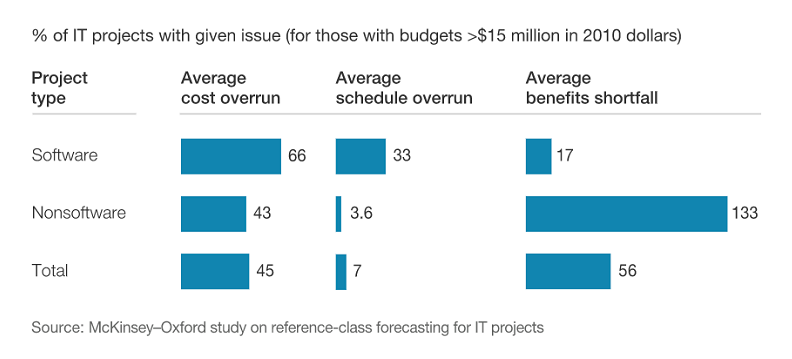Research Summary: “Delivering Large-Scale IT Projects On Time, On Budget, and On Value” By Michael Bloch, Sven Blumberg, & Jürgen Laartz, McKinsey & Company (2012)
Cost Overruns, Schedule Overruns, & Benefits Shortfalls, Oh My!
At Issue: Large IT projects often cost much more money and take much more time than planned; failed projects can put whole organizations in jeopardy. To defy the odds, companies must both understand the underlying causes of project failure and master the key dimensions that align IT project value with business value.
Research Objective(s): The research team’s objective was to determine how companies can maximize the likelihood that IT projects deliver their expected value on time and within budget.
Scope: The research focus was on large IT projects, defined as those with initial cost estimates exceeding $15 million.
Approach: The McKinsey team, working with the BT Centre for Major Programme Management at the University of Oxford, analyzed more than 5,400 IT projects by comparing predicted budgets, schedules, and performance benefits with actual costs and results. The team also conducted a survey of IT executives to determine the most common underlying causes for a project’s success or failure.
Findings: Large IT projects, on average, run 45 percent over budget and 7 percent over time, while delivering 56 percent less value than predicted. The longer an IT project is scheduled to last, the more likely that it will run over time and over budget; every additional year spent on a project increases cost overruns by an average of 15 percent. Approximately 17 percent of IT projects go so badly that they threaten the very existence of the company. Project underperformance or failure is most commonly caused by: (a) a misguided or lack of focus; (b) highly technical project complexity or ever-changing project requirements; (c) a misaligned or unskilled team; and/or (d) unrealistic scheduling or reactive planning. The four most effective ways to enable a project’s success are (1) focus on managing the project’s strategy and stakeholders rather than concentrating exclusively on budget and scheduling; (2) master the technology and project content by securing critical internal and external IT talent; (3) build effective business teams by aligning their incentives and needs with the overall goals of project; and (4) excel at core project-management practices, such as adhering to short delivery cycles and conducting rigorous quality checks.
Notes: The full results of this study can be accessed at https://www.mckinsey.com/business-functions/digital-mckinsey/our-insights/delivering-large-scale-it-projects-on-time-on-budget-and-on-value.
Researcher Profile: Allie Grace Garnett is a professional researcher and freelance writer with a background in finance and entrepreneurship. A serial entrepreneur who has established numerous businesses, Ms. Garnett previously was a founding Principal of Nexos Resource Partners (NRP), an energy project finance firm in New York. Prior to co-founding NRP, Ms. Garnett provided financial advisory and fund raising services to institutional-scale energy funds with Sustainable Development Capital. Ms. Garnett served as the Vice President of Marketing and Strategic Partnerships for the start-up Rentricity, and additionally founded a nonprofit organization (YAVA) that encourages volunteerism among college students. Ms. Garnett holds a Master of Business Administration degree from Harvard Business School and a Bachelor of Science in Civil Engineering degree from Northeastern University.





